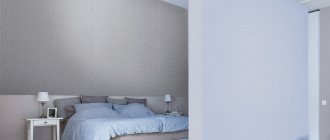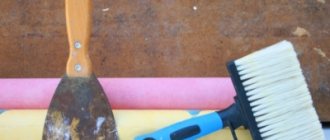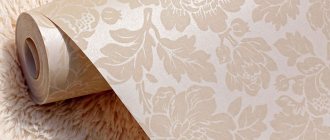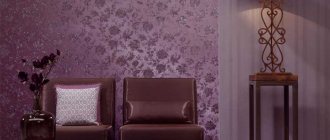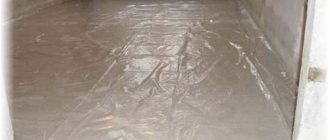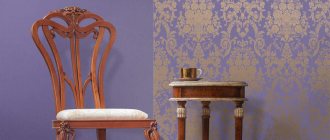Repairs, including those done by yourself, are a responsible undertaking and not always quick. There is not always plenty of time for it, so it is important to know exactly the duration of each stage. One of the most common activities when improving an apartment is wallpapering. It is permissible to use different types of such material, for example, non-woven, vinyl and some others.
However, when covering walls with any type of wallpaper, haste is not only inappropriate, but in most cases can harm the quality of this coating.
For this reason, it is very important to strictly follow all manufacturer's recommendations. And also know exactly how long it takes for wallpaper to dry after gluing, and how to speed up this process, without the risk of peeling and spoiling the appearance.
Important rules for wallpapering
To ensure that the quality of the walls and other surfaces is not affected, pay attention to the microclimate of the room. The best temperature for carrying out such work is +16 – +24 degrees. When the room is hotter, the glue dries quickly without having time to set.
Recommended humidity is 50-60%; at lower humidity, place containers of water in the room or use a spray bottle. When working on the sunny side, the windows are covered with curtains to protect from the heat. Windows and doors are closed to protect against drafts. It is permissible to open them only when the applied glue has completely hardened.
In order for the coating to dry quickly, it is important to wait until the primer applied to the wall dries. This will take 12-48 hours, depending on the thickness of the layer and the specific type of material. In the cold season, the unheated room is slightly warmed up in advance, but the temperature must be increased very slowly.
IMPORTANT! It is impossible to dry wallpaper of any type efficiently in less than half a day. Specialists who perform such work often play it safe and do not carry out any work in a room with freshly papered walls for up to five days. This precaution is especially important when working with “heavy” wallpaper.
Indoor microclimate
To obtain a good result when wallpapering, a suitable microclimate must be created in the building. Optimal temperatures range from +15 to +24 degrees.
In hotter room conditions, the adhesive solution will dry quickly and will need to be reapplied.
The humidity in the house should be at least 50%, preferably 60%. If you decide to hang wallpaper in the summer, then to improve the humidity level, you can spray water with a sprinkler. On the side where the sun is shining, it is worth covering the access to the sun's rays with thick curtains, this will reduce the heat.
Windows and doors are left closed during this period.
Optimal temperatures range from +15 to +24 degrees.
Current rules for wallpapering
To achieve the required quality result, you must adhere to the following rules:
- Before starting work, the doors and windows in the room are tightly closed, leaving them in this state for 48 hours after gluing. The canvases dry in 12-15 hours at a temperature of +19 – +22 degrees. However, for each type of material it is recommended to wait the time specified by the manufacturer.
- It is not advisable to turn on the air conditioner while wallpapering the walls - it will lead to evaporation of moisture and the room will become stuffy.
- Wallpaper glue is carefully diluted with water, avoiding the formation of clots and lumps, applied with a large brush or roller as evenly as possible, carefully distributing and paying special attention to the edges of the canvas.
- The fan will create unwanted movement of the air mass and sharply reduce the temperature, which will affect the quality of the gluing.
- It is not permissible to use any heating devices.
- The less time the door closes and opens into a freshly decorated room, the better. Ideally, they close it for at least two days and don’t enter.
GOOD TO KNOW! To check whether the wallpaper is dry or not, simply touch it with your hands in several places. Even if the material seems dry, wait another three to six hours.
Current relevance of the rule
When it comes to paper types of wallpaper, the rule of keeping windows and doors closed still holds true. To obtain the desired quality result, you need to follow a number of rules:
- During pasting and after its completion, you need to wait 2 days until the windows in the room can be opened. Paper webs dry after half a day if the temperature is +20 degrees. But it’s better to wait 2 days, because ensuring that the necessary conditions for drying are met is problematic;
- Turning on the air conditioner during this process is undesirable; when the moisture evaporates, the room will become stuffy;
- The use of a fan should also be avoided; it will disrupt the temperature regime and the readings will be unevenly distributed. Heating devices should not be used either.
To understand whether the coating has dried, touch the wallpaper with your hands; if it is dry, you should wait a little longer. If they are wet, wait for them to dry, and just in case, wait a couple of hours after that.
During pasting and after its completion, you need to wait 2 days until the windows in the room can be opened.
Drying time for wallpaper made from different materials
The drying speed of different types of wallpaper depends on the specific type. This point can be clarified with the seller when purchasing, as well as selecting the optimally suitable glue. Using thin paper webs, the degree of drying is often determined visually - the material is slightly translucent in some places.
How to work with paper wallpaper
Paper - with high-quality, professional preparation of the base, correct application of the primer and compliance with the technology for diluting the adhesive composition, the process will not take much time. Canvases with a top non-woven layer will dry in 48-60 hours, with vinyl - in 24-30 hours, simple paper - in 12 hours. Read also: is it possible to glue wallpaper on old wallpaper?
How long does non-woven wallpaper take to dry?
Non-woven fabrics are securely attached to the wall within 24 hours if the humidity does not exceed 60% and the temperature is +15 – +18 degrees. During the drying period, you should postpone all other finishing work in the room, do not open windows or doors. If these rules are not followed, the drying time may increase. Read our review: how to properly glue non-woven wallpaper with vinyl glue.
Vinyl coverings
The drying speed depends on the type of base of the product. Linens on a non-woven base dry for 36-48 hours if the humidity is low. Doors and windows cannot be opened. In cold, rainy seasons, wait five to seven days after gluing. Vinyl sheets with a paper backing dry in about 24 hours.
"Liquid wallpaper
The period for complete drying is usually indicated on the packaging. This is the longest drying material – up to three days when applied to “bare” concrete without thermal insulation. The time depends on the preparation of the base being prepared, the composition and thickness of the layer of the applied mixture, and the material used to make the walls. We recommend that you read the review: what surfaces can you apply liquid wallpaper to?
Compositions based on a polymer and with plant fibers dry faster, with mineral additives - slower.
The coating applied to gypsum putty dries faster than on a concrete wall. If the material does not stick when you touch it with your hand, it means it is dry. It is advisable not to touch the coating for the first 24-36 hours, so as not to spoil their appearance.
Wallpaper for painting
Under favorable conditions, they dry within a day, but they can be painted at least every other day.
Almost all types of wallpaper do not tolerate drafts well. This is explained by the fact that the glue has not yet dried, and the adhesion to the wall is weak. Rapid drying will disrupt the adhesion process - the canvas may even fall off. Particular care is taken when working with non-woven and paper coverings. The appearance of vinyl sheets can also deteriorate due to drafts.
RECOMMENDATION! For the highest quality gluing of “heavy” wallpaper, glue is applied not only to the canvases themselves, but also to the walls. This slows down the drying process by 6-10 hours, but improves the strength of the bond between the material and the base.
Factors affecting drying speed
There are certain rules for how wallpaper should dry.
- First of all, the speed of drying is affected by the base material. The better it absorbs moisture, the faster the glue dries. For example, gypsum surfaces dry faster than concrete surfaces. Additionally, each type of adhesive has a nominal drying time, which is also important to consider.
- Humidity conditions. High humidity (over 60%) will cause the material to take longer to dry. In addition, some products are quite hygroscopic; they will begin to absorb excess moisture, which can also damage the coating. Too low humidity will cause faster drying.
- Temperature conditions. Pasting can be done at a minimum of +7 degrees, and drying can be done at +15...+25. There should be no sudden temperature changes in the room, drafts are unacceptable, and it is prohibited to use heating devices while the material is drying.
Attention! Attempts to speed up the process can destroy the bond between the adhesive components, and the wallpaper will simply fall off the wall.
Dramatic changes in the climate in the room during drying of the wallpaper can lead to the opposite result.
After gluing is completed, it is necessary to stop all work in the room. If the question arises when you can open the windows after wallpapering, it is better to do this when the material is completely dry.
How to make the material dry quickly?
Experts do not recommend taking any action to speed up the drying of the wallpaper. But when there is very little time, it is permissible to carefully use some “tricks”.
- Reducing air humidity levels to 55-60%. Drafts are unacceptable under any circumstances, but a dehumidifier can be used. This device will rid the room of excess moisture, reducing the drying time. Its use is justified when a plaster solution in two or more layers was applied to the wall or a liquid floor coating was used. Turn on the dehumidifier a couple of hours before the start of work, as well as after its completion.
- Rising temperature in the room. The method is most relevant for rooms that were not heated before renovation. In cold weather they need to be warmed up well. Before starting work, you can use any heating device, but during the process and a day after it, it is prohibited to use converter-type devices, as well as “heat guns”. The best option is an oil heater, which does not create air currents, ensures uniform heating, and keeps the temperature at the same level, without sudden changes.
Beginners often try to use a fan. This is the most undesirable way to dry canvases. The fan creates air movement, leading to uneven cooling of the space. The canvases may partially or completely come off - re-gluing them will be problematic.
How to speed up the process
It is not recommended to speed up this stage using professional technology, and this applies to all types of canvases. But, when the work was deliberately carried out in violation, then you need to be prepared for the appearance of defects during gluing. In some cases, this is justified by circumstances that do not allow for a long wait.
It is not recommended to speed up this stage using professional technology, and this applies to all types of canvases.
The choice of glue depending on the type of wallpaper
It is best to purchase the composition indicated on the packaging by the wallpaper manufacturer. Each type of material has its own special products, which take into account the features, characteristics and drying times of the coating.
Paper webs
They have minimal weight and are used to work with them:
- Homemade paste. To improve adhesion (sticking), a certain amount of PVA glue is added to it. Made from flour or starch from potatoes and used for gluing for 15 hours. After this period, it is no longer suitable for work.
- CMC glue (carboxyl methylcellulose). That's what it's called. You can purchase a powdery substance at any hardware store. In a tightly closed container, the diluted composition can retain its properties for up to 7 days. In dry form - more than a year.
- In addition to the listed types, you can use any glue marked “Universal”.
Non-woven fabrics
This type of coating is considered heavy. Therefore, a specialized composition is used for them, which will reliably hold them. An adhesive that says “Non-woven”, “Ultra-premium” or “Reinforced” on the packaging is suitable. They have fungicidal agents and special components that do not allow the wallpaper to be separated during subsequent finishing.
Only the walls are treated with the diluted mixture; the solution is not applied to the sheet. To improve adhesion, the walls must first be coated with a primer.
Vinyl coverings
This type is slightly heavier than paper ones and is considered a “medium” category, but gluing is carried out according to the same principle - the solution is applied to the sheet, and not to the wall surface.
As a rule, the vinyl base does not allow air to pass through, which affects the drying time of the adhesive composition; for this reason, homemade paste is not used in this case - only specially designed MC-based adhesive is suitable.
The packaging says “Vinyl” or “Vinyl” which contains antifungal components and dries quickly, creating a transparent thin film between the wall surface and the wallpaper sheet.
"Liquid wallpaper
Liquid wallpaper does not need glue, but before applying the wallpaper, the surface of the walls is pre-primed. For this purpose, for example, the “Moment” primer for treating walls is used. You can find out how to remove liquid wallpaper from walls from our review.
How to reduce humidity
Drafts should not be allowed, so it is better to use a dehumidifier; this device will remove excess moisture and reduce drying time. It is usually used if several layers of plaster mortar were applied, or liquid types of flooring were used. It is better to start it before the gluing process, and after gluing is completed, turn on the device again.
You should not reduce the humidity too much; it is advisable to bring it to 50-60%.
Drafts should not be allowed, so it is better to use a dehumidifier; this device will remove excess moisture and reduce drying time.
How to paint wallpaper?
Water-dispersed paint suitable for wallpaper should be diluted with water by 5-15%. In general, the thinner the paint, the easier it is to apply.
First you need to work with a brush. Go through the entire perimeter of the wall: corners, under the ceiling and near the floor. Then take a roller and quickly, without stopping or smoking breaks, paint the entire wall from corner to corner.
The roller should always be well moistened with paint. No need to squeeze it out. The roller does not rub the wall; it is rolled with light and quick movements.
The paint can be applied in a zigzag (w-shape) motion or in vertical stripes. In any case, the border between segments (squares, stripes) must be rolled up immediately. In general, you should paint very quickly. This is important, because all transitions must be rolled up before the paint begins to dry.
Recommendations and important points
Heat guns used when installing suspended ceilings sharply increase the temperature in the room.
- When you plan to install suspended ceilings, it should be postponed. During installation, the air in the room heats up quite strongly. This may cause the panels to peel off.
- The installation of an air conditioner or split system also needs to be delayed, at least 7 days. This is due to drilling mounting holes in the wall. They will cause a draft. In addition, it will not be possible to check the operation of the equipment, because this will create air currents and the temperature will change.
Drafts and temperature changes can cause wallpaper joints to peel off.
Note! The best option, after you paste the wallpaper yourself, is to leave the room closed for several days. If possible, it is better not to enter it. By opening the door to the room, you will create, albeit small, air flows. They can cause the finish to peel off from the walls.
- For the entire period of drying the wallpaper, the room must be protected from drafts, as well as sudden changes in temperature and air humidity.
- Experts say that it is extremely undesirable to force the coating to dry, sharply raise the air temperature in the room, or create artificial flows of warm air.
Which roller should I use for painting wallpaper?
It is recommended to paint with a velor or fur roller with short or medium pile. The deeper the wallpaper relief, the longer the roller pile.
The foam roller is not suitable.
New rollers often lose lint during the painting process. They stick to the paint and remain on the wall. To avoid this, it is recommended to carefully roll the new roller along the adhesive side of the tape. Poorly adherent lint will remain on the adhesive tape.
Types of wallpaper with vinyl coating
The wallpaper in the photo is silk-screen printing.
There are 3 types of wallpaper with a top vinyl layer: non-woven analogues (smooth), with foamed polyvinyl chloride and silk-screen printing (fabric).
- To create textured patterns or special effects, manufacturers use non-woven PVC wallpaper . The material consists entirely of polymer, therefore it is most resistant to wear and moisture.
Foamed vinyl is heavy and takes a long time to dry.
- Foamed vinyl adds extra dimension to walls . It is produced using special dyes. During heat treatment, they seem to “explode”, forming a convex and soft texture. Thick canvases with deep relief add luxury to the interior.
- The price of fabric wallpaper is the highest . With their appearance they successfully imitate natural silk or satin. The fabric structure makes the coating durable and strong. (See also the article Wallpaper with imitation plaster: types.)
Materials and tools
Due to their high density, paper-based vinyl wallpaper is difficult to glue. The process of finishing walls will be simplified by high-quality wallpaper, a good paste and a set of tools.
Materials you need to buy:
- rolls of vinyl trellises;
- paste for paper base;
- primer.
The list of tools and devices should include:
- stepladder or strong table;
- containers for glue and clean water;
- primer cuvette;
- a screwdriver with a mixing attachment for diluting glue. If you don't have one, any hard object will come in handy. As a last resort, you can use your hand;
- a rule or even strip for marking the wall;
- roller for applying primer;
- paint brush for primer (apply primer in corners and at the junctions of walls with the ceiling and floor) and glue - to spread trellises;
- homemade plumb line or laser level;
- chalk or construction pencil;
- roulette;
- knife;
- wide metal spatula;
- wallpaper spatula;
- large rubber roller;
- small cone-shaped roller;
- a small brush for applying glue to the edges of wallpaper on the wall;
- rags (napkins) for glue.
Calculation of the number of wallpapers
In practice, the number of wallpapers is determined in two ways.
Method No. 1. Using a tape measure, measure the height of the surface to be pasted. After this, the length of the roll is divided by the number obtained during measurements - the number of trellis sheets in one tube is obtained.
At the next stage, the length of all walls is measured and divided by the width of the wallpaper. The resulting total number of sheets for gluing is divided by the number of sheets in one roll = number of rolls.
The above measurements can be expressed by the formula:
P = T/L x M/K + 1(2) , where:
- P—number of tubes, pcs.;
- T—length of all walls, m;
- L—roll width (0.53 m);
- M—length of the sheet to be glued, m;
- K—roll length (10 m, 15 m, 25 m);
- 1(2) - additional number of trellises, pcs.
When the height of the print (drawing) is more than 60 mm, one more roll is added to every 6 trellis tubes.
Method No. 2. The area of the room and the height of the ceiling are determined, after which the result is in Table 1. It takes into account natural losses, but not the adjustment of the drawing. Therefore, you need to make adjustments to the height of the print.
Table 1. Calculation of paper-based vinyl wallpaper tubes.
| Indoor ceiling height | |||
| Standard ceiling - 2.5 m | High ceiling - 2.6-3 m | ||
| Room area, m2 | Number of tubes | Room area, m2 | Number of tubes |
| 6 | 5 | 6 | 7 |
| 10 | 6 | 10 | 9 |
| 12 | 7 | 12 | 10 |
| 14 | 8 | 14 | 10 |
| 16 | 8 | 16 | 11 |
| 18 | 9 | 18 | 12 |
| 20 | 9 | 20 | 13 |
| 22 | 10 | 22 | 14 |
| 24 | 10 | 24 | 15 |
| 26 | 11 | 26 | 16 |
| 28 | 11 | 28 | 17 |
| 30 | 12 | 30 | 18 |
Preparatory work
Any type of wall decoration begins with preparatory work. Gluing vinyl trellises is no exception. Preparations consist of preparing:
- wall surfaces;
- trellis;
- paste.
Preparing the walls
The quality of wall decoration with vinyl wallpaper and its service life directly depend on the efforts made to prepare the surface for gluing. It should be smooth, dry and free of dirt. The work must be carried out, but without fanaticism - most types of trellises mask minor defects well. The preparation technology is described in detail in the material “How to prepare walls for wallpapering.” Let us briefly recall what it says:
- sconces, fasteners, sockets, switches are removed from the surface of the walls;
- The floor and ceiling plinths are removed. It is advisable to remove the trim from the interior doors. This will somewhat lengthen the process of finishing the walls, but will eliminate the difficulties of passing the doorway;
- old finishing is removed: wallpaper is torn off, paint is peeled off, decorative plaster is knocked off;
- The walls are carefully examined and tapped. If “swelling” areas are detected, the plaster is removed;
- chips and cracks are repaired with repair mortar;
- dirt, soot and grease are removed;
- the cleaned wall is treated with a primer;
- if necessary, plastering work is carried out, after which the surface is primed again;
- a layer of putty is applied. If the operation is not necessary for plaster and concrete, then for gypsum plasterboard it must be carried out. Otherwise, when removing the annoying wallpaper, you will have to regret it - along with the wallpaper, the paper layer will be torn off from the drywall;
- the wall is primed again (preferably, especially under heavy wallpaper) with glue. For these purposes, you can use a universal primer or highly diluted glue;
- All windows close tightly, regardless of the time of year (summer or winter). The slightest draft leads to the wallpaper coming off the wall.
Preparing wallpaper
Professional finishers try to avoid combining dry and wet processes when gluing wallpaper. Therefore, first, wallpaper is cut to size for the entire room. You can organize your work correctly using the following algorithm:
- a diagram of the placement of each sheet of wallpaper is drawn up (see figure);
Scheme for decorating a room.
- The height of the surface to be pasted is measured. If there is a plinth, small tolerances are made, 2-3 cm near the floor and ceiling - then you will have to trim both at the top and bottom. If the baseboard is removed everywhere, the work becomes easier. You can measure accurately, and millimeter differences will be hidden by the baseboard;
- trellises are rolled out on any flat surface. Basically it's the floor;
- the length of the first sheet is measured;
- the wallpaper is bent. The bend is smoothed by hand to make cutting easier;
You can cut it like that.
So. But this method is more convenient.
- if there is no print on the wallpaper, there is no need to adjust it according to the pattern - the roll is rolled back and forth until it runs out;
- folds are rolled with a roller or smoothed by hand;
- the canvas is cut into sheets.
If it is necessary to adjust the drawing, the work is carried out in a different sequence:
- the first sheet is cut off and turned over with the pattern facing up;
- the tube rolls out again;
- the pattern is adjusted;
- the second sheet is cut along the lower edge of the first. The top should be trimmed on the wall, because It's easy to make a mistake on the floor;
Combining the drawing.
- the cut sheets are numbered - they must match the positions on the diagram.
The work is completed after sheets have been cut for the entire room.
Glue preparation
Paste for vinyl wallpaper is prepared in the same way as for paper, according to the instructions printed on the packaging. Given the heavy weight of the canvases, it is necessary to strictly follow the manufacturers' recommendations. Otherwise, you may end up with peeling wallpaper, if not immediately, then after 3-4 years. All the features of preparing the paste are given here.
What you should definitely pay attention to
The first thing to consider is the labeling of the wallpaper. Each roll has a label. It contains icons, or pictograms, that have their own designation, for example:
- Icon with a tassel and a vertical stripe. This indicates that the canvas is not saturated with glue. You just need to apply it to the walls.
- Brush icon and horizontal stripe. This means that they need to be pre-impregnated with glue.
- Shown is a container with a roll. These wallpapers already have glue. It is applied at the manufacturer's factory. During repairs, the canvas is simply moistened with water.
You need to purchase the glue that will match the purchased type of wallpaper.
Paint selection
For fiseline wallpaper, only water-based paints . They should not contain solvents.
The advantages of these paints are that they are not harmful to health, as they do not contain aggressive chemicals.
Therefore you can choose:
- latex-based water-dispersion paint;
- water-based;
- acrylic.
Paint that creates a water-repellent film will allow you to wash the wallpaper later. And this will help keep the walls clean, so they will have a well-groomed appearance for many years.
Is it possible to turn on the fan?
During operation, the fan distributes air into different zones, so the temperature in different parts of the room where the renovation was carried out will be non-uniform. In turn, the glue does not dry solidly, so as a result, the wallpaper may peel off in places, or some of the canvases will fall off entirely. You will need to re-glue these areas, or re-glue the entire strips.
During operation, the fan distributes air into different zones, so the temperature in different parts of the room where the renovation was carried out will be non-uniform.
The stage of drying the wallpaper is an important part of the repair; therefore, it is advisable to follow the rules of this stage. If you take your time and create optimal conditions for the canvases to dry, then gluing them to the surface will proceed without defects, and you won’t have to glue them twice. When determining the required deadlines, pay attention to the type of base and the type of wallpaper itself. As a result, you can get high-quality wallpaper that will perfectly complement the design of the room.
Popular manufacturers and prices
The price of vinyl wallpaper is influenced by many factors:
- fabric density;
- number of paper layers;
- vinyl application technology;
- methods for obtaining relief (texture);
- dyeing methods;
- brand promotion - so-called image boosts or brand price.
Therefore, we present the average cost for individual types, indicating the lower and upper limits.
Attention: the prices indicated may differ slightly from the real ones due to changes in the dollar and Euro exchange rates - most vinyl wallpapers are imported.
- The simplest smooth wallpaper can be bought for 150-900 rubles per tube.
- Foamed vinyl costs a little more - 300-500 rubles per tube.
- Silk-screen printing - 700-1500 rubles per roll.
- For solid polyvinyl chloride you will have to pay a tidy sum - 1500-3500 rubles/roll.
Vinyl wallpaper is produced at many enterprises. With a paper base, the best products are from:
- "Rasch Sintra";
- "Zambaiti Parati";
- "Casamance"
- "Beaconprint".
"Rasch Sintra". The German-Ukrainian enterprise Rasch Sintra is part of the Tapetenfabrik Gebr concern. Rash GmbH&Co KG. Specializes in the production of all types of wallpaper. The line of vinyl paper-based trellises is updated annually thanks to a powerful team of architects and designers. As a result, as of mid-2021, the number of articles of this type of trellis amounted to several thousand.
Wallpaper "Rasch Sintra".
The concern's products:
- huge assortment selection;
- unlimited scope of application;
- high strength;
- practicality in care;
- resistance to burnout;
- the ability, when removing the top decorative layer, to leave the paper on the wall as a basis for another decorative coating;
- the ability to combine wallpaper from different collections on one surface - the print matches.
There are also disadvantages:
- high price - the cheapest roll can be bought for 500 rubles;
- many fakes;
- defect from the Ukrainian manufacturer.
"Zambaiti Parati". The Italian company (Zambaiti Paraty), thanks to modern equipment and the professionalism of the company's employees, produces high-quality trellises with unique prints and beautiful shades. The product line includes wallpaper designs for every taste.
Wallpaper "Zambaiti Paraiti" in the interior.
Collection "Odeon".
Among the advantages are:
- a huge assortment of trellises not only in texture, design and color, but also in types of technologies - all possible lines for the production of trellises, at the time of preparation of the article, were introduced at the enterprise;
- high density ensuring wear resistance;
- ability to operate in wet areas;
- color fastness equivalent to durability;
- simple gluing.
Minus two:
- high cost - the price starts from 1500 rubles. per roll;
- a defect that sometimes occurs at the company's enterprises located in Russia and China.
"Casamance". The French brand Casamance is known for its elegant and at the same time original style. This approach allowed the young company to become a prominent figure in the production of vinyl wallpaper in Europe and the world in just 20 years.
Wallpaper "Casamance".
Products highlight:
- variety of model ranges;
- high strength;
- long service life;
- natural dyes;
- moisture and color resistance;
- simple gluing;
- no special requirements for the composition of the paste.
Flaws:
- high price - the cost of a roll starts from 2500 rubles;
- a large number of counterfeits that the factory cannot protect against.
"Beaconprint". The Russian manufacturer of vinyl wallpaper has been working in this area for just over 10 years. During this time, designers and artists have developed several unique collections. For example, particles of mother-of-pearl, varnish, and glitter began to be added to the composition of the vinyl layer.
The advantages of the product include:
- an extensive range, despite the short period of work;
- good adhesion to all types of walls;
- high density, which allows you to obtain a durable, wear-resistant wallpaper;
- moisture resistance, allowing:
- glue trellises to the walls in the kitchen and bathroom;
- wash with a damp cloth.
- environmental Safety.
Disadvantages quite spoil the reputation of the enterprise:
- high cost, which is a significant drawback for a brand from Russia - the handset can be purchased from 500 rubles;
- do not like currents of frosty air. Therefore, in the cold season (late autumn, winter and early spring), it is not recommended to open the windows wide - they may come unglued;
- It’s difficult to glue on your own due to the high density - you need a partner;
- On sale there are completely defective rolls, and not in small sections, as with other manufacturers, which indicates poorly established control over product quality.
One print in different colors.




